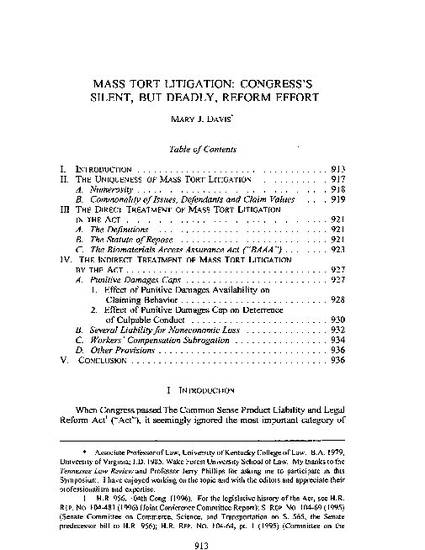
This article explores the ways in which The Common Sense Product Liability and Legal
Reform Act (“Act”) treats mass tort litigation issues. The Act does so both directly and indirectly. The direct methods of reform are mostly industry-specific and, thus, almost inconsequential in contrast to the indirect treatment. The indirect, almost clandestine, methods of reform are the most insidious and provide the most cause for concern as Congress once again attempts to "reform" products liability by reintroducing the Act in 1997. Given the President's early indication that a reform measure could meet with his approval, but that this one in its present form did not, it is not surprising that Congress is reviving the Act this term. This action illustrates Congress's failure to recognize the significant differences between mass tort litigation and "run-of-the-mill" products liability litigation' and shows, at the very least, a startling lack of understanding of the complexity of current product liability litigation and, at most, a purposeful effort to immunize from responsibility those who cause the greatest harm to the largest number of people.
This article examines the ways in which the Act would significantly affect mass tort litigation to the detriment of claimants and concludes that the rights and responsibilities so dramatically juxtaposed in mass tort litigation are neither fully nor fairly addressed. As with most litigation phenomena, the alleged "crisis du jour" which Congress treats in the Act leads, as do hard cases, to bad law particularly in the mass tort context. A more focused and dispassionate review of the needs of mass tort litigation appears in order and has, in fact, been ongoing for several years.
One of the stated purposes behind the Act is to reduce the unacceptable costs and delays in our civil justice system associated with excessive litigation. A primary culprit in causing the delays has been mass tort claims which have "threatened to overwhelm the civil justice system, accounting for more than one-quarter of the entire civil caseload in certain courts.” In addition, only ten to twenty percent of potential tort plaintiffs, and a mere two to ten percent of product accident victims pursue a claim, while 100 to 200 percent of mass tort victims actually file suit. Thus, the need for reform of run-of-the mill products litigation is suspect in light of the claiming behavior of accident victims. Congress's intent primarily to deal with a litigation crisis in that arena becomes more and more unlikely. Rather, it would not be farfetched to suggest that it is mass tort litigation that was a primary aim of Congress's reform efforts because it is the most drastically affected by the Act's attempts to correct the perceived wrongs of juries and litigants of the past decades.
- Legislation and
- Torts

Tennessee Law Review, Vol. 64, No. 3 (Spring 1997), pp. 913-937